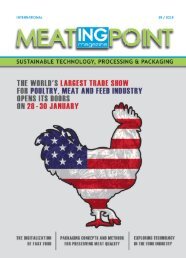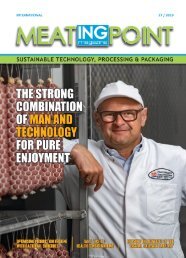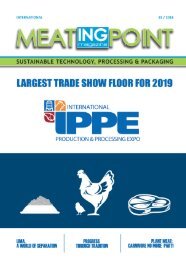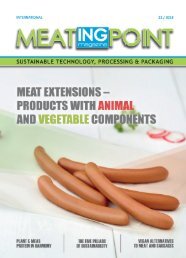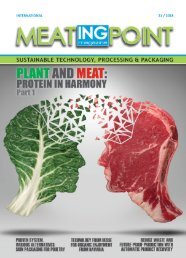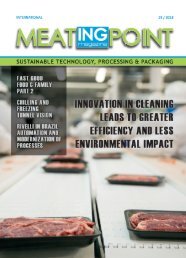MEATing POINT Magazine: #08/ 2016
You also want an ePaper? Increase the reach of your titles
YUMPU automatically turns print PDFs into web optimized ePapers that Google loves.
ENERGY EFFICIENCY<br />
modifications to site infrastructure. Finning<br />
offers a comprehensive feasibility service,<br />
which includes checking the gas supply and<br />
assessing the electrical connection for the<br />
CHP power element among others.<br />
The efficiency of a CHP system requires<br />
the equipment to be sized correctly, which<br />
depends on a plant’s base electrical load<br />
profile. As a site’s electricity requirement can<br />
potentially vary quite drastically throughout<br />
a year, calculating the base level of electrical<br />
consumption correctly will ensure the CHP<br />
system can withstand the day-to-day<br />
demands placed on it.<br />
If the system is too small the site will have<br />
to buy in additional gas or electricity, but<br />
if it’s too big some of the heat or power it<br />
produces may be wasted.<br />
Any planned changes to production levels<br />
or the scale of production should also be<br />
taken in to consideration as these can affect<br />
the size of the gas engine specified.<br />
record of delivering CHP systems, who<br />
considers each site’s individual requirements.<br />
Finning not only offers expert advice and<br />
guidance on the specification and installation<br />
of the correct CHP unit to meet individual<br />
requirements, but also provides an O&M<br />
contract to help ensure efficiencies are<br />
delivered as expected.<br />
With a payback period of as little as three<br />
years, CHP and trigeneration presents<br />
an opportunity for cost-conscious meat<br />
processing plants. If operators take advantage<br />
of this, significant cost savings and energy<br />
efficiencies can be realised, helping meat<br />
processing plants to maximise profitability<br />
and maintain productivity.<br />
References:<br />
[1] Resource Use in the British Beef and Lamb<br />
Processing Sector, AHDB Beef & Lamb<br />
http://beefandlamb.ahdb.org.uk/wp/wp-content/<br />
MEC16_127x140_Meating Point_high.pdf 1 8/6/<strong>2016</strong> 4:14 PM<br />
uploads/2013/04/resourceuseenergy_100211-<br />
factsheet-4.pdf<br />
[2] Energy Consumption Guide for Small to<br />
Medium Red Meat Processing Facilities, Australian<br />
Meat Processor Corporation<br />
http://www.ampc.com.au/site/assets/media/reports/<br />
ENV/Energy/ENERGY-CONSUMPTION-<br />
GUIDE-FOR-SMALL-TO-MEDIUM-RED-<br />
MEAT-PROCESSING-FACILITIES.pdf<br />
[3] The CHPQA Standard Issue 5, the Department<br />
of Energy and Climate Change.<br />
https://www.gov.uk/government/uploads/<br />
system/uploads/attachment_data/file/335471/<br />
CHPQAStandardIssue5.pdf<br />
[4] Why Use CHP? The Local Government<br />
Association<br />
http://www.local.gov.uk/climate-change/-/<br />
journal_content/56/10180/3510573/ARTICLE<br />
[5] Red Meat Processing Industry Energy<br />
Efficiency Manual, Australian Meat Processor<br />
Corporation<br />
http://www.ampc.com.au/site/assets/media/<br />
reports/ENV/Doug/On-Site-Energy-Generation/<br />
Cogeneration.pdf<br />
Every site will have its own ratio between how<br />
much power it needs and how much heat it<br />
needs. For example, a beef processing site<br />
may require 1300-1400 kW of heat and<br />
1300-1400 kW of electricity to operate<br />
to maximum production output. In a<br />
conventional installation, the heat will be<br />
provided by a series of gas boilers and the<br />
electricity purchased directly from the grid.<br />
C<br />
M<br />
In contrast, a CHP installation may produce<br />
Y<br />
1200 KWe of heat and electricity respectively<br />
CM<br />
from one natural gas fuel source, meaning<br />
that the operator can significantly reduce its MY<br />
utility costs, importing only the additional<br />
CY<br />
power it needs above the 1200kWe base.<br />
CMY<br />
Exploring your options<br />
K<br />
CHP installations are designed with this<br />
ratio in mind, and are able to meet the base<br />
load consumption during a full production<br />
year after accounting for the peaks and<br />
troughs in output. Any energy shortfalls at<br />
periods of high demand can be made up<br />
using bought-in gas or electricity.<br />
It is also advisable to purchase an operations<br />
and maintenance (O&M) contract at the<br />
same time as installation. Operators should<br />
seek a trusted partner with a strong track<br />
issue 8 | www.meatingpoint-mag.com<br />
www.finning.co.uk<br />
49




